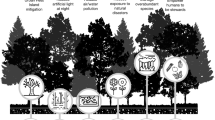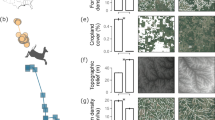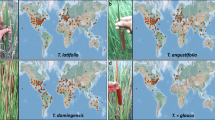Abstract
We determined the influence of habitat, landscape, geographic, and climate variables on Sedge Wren (Cistothorus platensis) and Marsh Wren (C. palustris) occurrence in 840 coastal wetland survey points throughout the Great Lakes. Variables included surrounding land use and configuration out to 2000 m; latitude; longitude; temperature; precipitation; and vegetation characteristics within 100 m. Classification trees predicted Sedge Wren occurrence at points in the western Great Lakes with < 11 km of roads within 1000 m. Emergent herbaceous wetland within 500 m, woody wetland within various distances, and sedge within 100 m were also positively associated with Sedge Wren occurrence. Marsh Wren occurrence was predicted at points in the southern Great Lakes with < 42% developed land within 500 m. Emergent herbaceous wetland within 500 m, cropland within various distances, and cattail within 100 m were also positively associated with Marsh Wren occurrence. Our results suggest limiting development around wetlands is important for conserving these bird species throughout Great Lakes coastal wetlands. Landscape-scale land cover variables are easily obtainable and significantly increase our ability to predict occurrence of these species across a broad geographic scale.





Similar content being viewed by others
References
Bakker KK, Naugle DE, Higgins KF (2002) Incorporating landscape attributes into models for migratory grassland bird conservation. Conservation Biology 16:1638–1646
Baker DB (1993) The Lake Erie agroecosystem program: water quality assessments. Agriculture, Ecosystems and Environment 46:197–215
Barker FK (2004) Monophyly and relationships of wrens (Aves: Troglodytidae): a congruence analysis of heterogeneous mitochondrial and nuclear DNA sequence data. Molecular Phylogenetics and Evolution 31:486–504
Beyer HL (2012) Geospatial modelling environment version 0.7.2.1. http://www.spatialecology.com/gme
BirdLife International and NatureServe (2014) Bird species distribution maps of the world. BirdLife International, Cambridge, UK and NatureServe, Arlington, USA
Bourg NA, McShea WJ, Gill DE (2005) Putting a CART before the search: successful habitat prediction for a rare forest herb. Ecology 86:2793–2804
Brazner JC, Danz NP, Niemi GJ, Regal RR, Trebitz AS, Howe RW, Hanowski JM, Johnson LB, Ciborowski JJH, Johnston CA, Reavie ED, Brady VJ, Sgro GV (2007) Evaluation of geographic, geomorphic and human influences on Great Lakes wetland indicators: a multi-assemblage approach. Ecological Indicators 7:610–635
Breiman L, Friedman JH, Olshen RA, Stone CJ (1984) Classification and regression trees. Wadsworth, Belmont
Burns JT (1982) Nests, territories, and reproduction of Sedge Wrens (Cistothorus platensis). The Wilson Bulletin 94:338–349
Conway CJ (2011) Standardized North American marsh bird monitoring protocol. Waterbirds 34:319–346
Cunningham MA, Johnson DH (2006) Proximate and landscape factors influence grassland bird distributions. Ecological Applications 16:1062–1075
Danz NP, Regal RR, Niemi GJ, Brady VJ, Hollenhorst T, Johnson LB, Host GE, Hanowski JM, Johnston CA, Brown T, Kingston J, Kelly JR (2005) Environmentally stratified sampling design for the development of Great Lakes environmental indicators. Environmental Monitoring and Assessment 102:41–65
De’ath G, Fabricius KE (2000) Classification and regression trees: a powerful yet simple technique for data analysis. Ecology 81:3178–3192
DeLuca WV, Studds C, Rockwood LL, Marra PP (2004) Influence of land use on the integrity of marsh bird communities of Chesapeake Bay, USA. Wetlands 24:837–847
Environment Canada and U.S. EPA (2009) State of the Great Lakes Ecosystem Conference. http://binational.net/solec/sogl2009/sogl_2009_h_en.pdf
ESRI (2013) ArcGIS desktop: release 10.2. Environmental Systems Research Institute, Redlands
Fairbairn SE, Dinsmore JJ (2001) Local and landscape-level influences on wetland bird communities of the prairie pothole region of Iowa, USA. Wetlands 21:41–47
Fletcher RJ, Koford RR (2002) Habitat and landscape associations of breeding birds in native and restored grasslands. The Journal of Wildlife Management 66:1011–1022
Forcey GM, Linz GM, Thogmartin WE, Bleier WJ (2007) Influence of land use and climate on wetland breeding birds in the Prairie Pothole region of Canada. Canadian Journal of Zoology 85:421–436
Franklin J (1998) Predicting the distribution of shrub species in southern California from climate and terrain-derived variables. Journal of Vegetation Science 9:733–748
Hanowski J, Danz N, Howe R, Niemi G, Regal R (2007) Consideration of geography and wetland geomorphic type in the development of Great Lakes coastal wetland bird indicators. EcoHealth 4:194–205
Herkert JR, Kroodsma DE, Gibbs JP (2001) Sedge Wren (Cistothorus platensis). In: Poole A (ed) The birds of North America online, Ithaca: Cornell Lab of Ornithology. http://bna.birds.cornell.edu/bna/species/582
Homer C, Dewitz J, Fry J, Coan M, Hossain N, Larson C, Herold N, McKerrow A, VanDriel JN, Wickham J (2007) Completion of the 2001 National Land Cover Database for the conterminous United States. Photogrammetric Engineering and Remote Sensing 73:337–341
Horn DJ, Koford RR (2004) Could the area-sensitivity of some grassland birds be affected by landscape composition? Proceedings of the North American Prairie Conferences 74:109–116
Howe RW, Regal RR, Hanowski J, Niemi GJ, Danz NP, Smith CR (2007) An index of ecological condition based on bird assemblages in Great Lakes coastal wetlands. Journal of Great Lakes Research 33:93–105
Iverson LR, Prasad AM (1998) Predicting abundance of 80 tree species following climate change in the Eastern United States. Ecological Monographs 68:465–485
Johnson DH (1980) The comparison of usage and availability measurements for evaluating resource preference. Ecology 61:65–71
Johnston CA, Zedler JB, Tulbure MG, Frieswyk CB, Bedford BL, Vaccaro L (2009) A unifying approach for evaluating the condition of wetland plant communities and identifying related stressors. Ecological Applications 19:1739–1757
Johnston KJ, Ver Hoef JM, Krivoruchko K, Lucas N (2001) Using ArcGIS geostatistical analyst. ESRI, USA
Kroodsma DE, Verner J (2014) Marsh Wren (Cistothorus palustris). In: Poole A (ed) The birds of North America online, Ithaca: Cornell Lab of Ornithology. http://bna.birds.cornell.edu/bna/species/308
Le Rest K, Pinaud D, Bretagnolle V (2013) Accounting for spatial autocorrelation from model selection to statistical inference: application to a national survey of a diurnal raptor. Ecological Informatics 14:17–24
Lougheed VL, Crosbie B, Chow-Fraser P (2001) Primary determinants of macrophyte community structure in 62 marshes across the Great Lakes basin: latitude, land use, and water quality effects. Canadian Journal of Fisheries and Aquatic Sciences 58:1603–1612
Mathieu R, Seddon P, Leiendecker J (2006) Predicting the distribution of raptors using remote sensing techniques and geographic information systems: a case study with the Eastern New Zealand Falcon (Falco novaeseelandiae). New Zealand Journal of Zoology 33:73–84
McGarigal K, Cushman SA, Ene E (2012) FRAGSTATS v4: spatial pattern analysis program for categorical and continuous maps. Computer software program produced by the authors at the University of Massachusetts, Amherst
McKee PM, Batterson TR, Dahl TE, Glooschenko V, Jaworski E, Pearce JB, Raphael CN, Whillans TH, LaRoe ET (1992) Great Lakes aquatic habitat classification based on wetland classification systems. In: Busch W‐DN, Sly PG (eds) The development of an aquatic habitat classification system for lakes. CRC Press, Boca Raton, pp 59–72
Mills EL, Casselman JM, Dermott R, Fitzsimons JD, Gal G, Holeck KT, Hoyle JA, Johannsson OE, Lantry BF, Makarewicz JC, Millard ES, Munawar IF, Munawar M, O’Gorman R, Owens RW, Rudstam LG, Schaner T, Stewart TJ (2003) Lake Ontario: food web dynamics in a changing ecosystem (1970–2000). Canadian Journal of Fisheries and Aquatic Sciences 60:471–490
Morrice JA, Danz NP, Regal RR, Kelly JR, Niemi GJ, Reavie ED, Hollenhorst T, Axler RP, Trebitz AS, Cotter AM, Peterson GS (2008) Human influences on water quality in Great Lakes coastal wetlands. Environmental Management 41:347–357
Oceanic N, Administration A (2012) North American Regional Reanalysis data provided by the NOAA/OAR/ESRL PSD. Boulder, Colorado
Naugle DE, Johnson RR, Estey ME, Higgins KF (2001) A landscape approach to conserving wetland bird habitat in the Prairie Pothole region of eastern South Dakota. Wetlands 21:1–17
Nevers M, Hanowski J, Niemi G (1981) Forty-fourth breeding bird census, 203. Shrub swamp American Birds 35:100
Niemi GJ (1985) Patterns of morphological evolution in bird genera of new world and old world peatlands. Ecology 66:1215–1228
Niemi GJ, Hanowski JM (1984) Effects of a transmission line on bird populations in the Red Lake peatland, northern Minnesota. The Auk 101:487–498
Niemi GJ, Kelly J, Danz N (2007) Environmental indicators for the North American Great Lakes coastal region: introduction and prospectus. Journal of Great Lakes Research 33:1–12
Ontario Ministry of Natural Resources (2002) Ontario Land Cover data. Toronto, Ontario
Peterjohn BG (2001) The birds of Ohio. Indiana University Press, Bloomington
Peterson AC, Niemi GJ (2007) Evaluation of the Ohio rapid assessment method for wetlands in the western Great Lakes: an analysis using bird communities. Journal of Great Lakes Research 33:280–291
Pimentel D, Allen J, Beers A, Guinand L, Linder R, McLaughlin P, Meer B, Musonda D, Perdue D, Poisson S, Siebert S, Stoner K, Salazar R, Hawkins A (1987) World agriculture and soil erosion. BioScience 37:277–283
Quesnelle PE, Fahrig L, Lindsay KE (2013) Effects of habitat loss, habitat configuration and matrix composition on declining wetland species. Biological Conservation 160:200–208
R Core Team (2013) R: A language and environment for statistical computing. R Foundation for Statistical Computing, Vienna, Austria. ISBN 3-900051-07-0. http://www.R-project.org
Riffell SK, Keas BE, Burton TM (2003) Birds in North American Great Lakes coastal wet meadows: is landscape context important? Landscape Ecology 18:95–111
Robert M, Jobin B, Latendresse C, Giguère S, Shaffer F (2009) Habitat use by Sedge Wrens in southern Québec. The Wilson Journal of Ornithology 121:347–358
Rotenberry JT, Wiens JA (2009) Habitat relations of shrubsteppe birds: a 20-year retrospective. The Condor 111:401–413
Sauer JR, Hines JE, Fallon JE, Pardieck KL, Ziolkowski DJ Jr, Link WA (2014) The North American breeding bird survey, results and analysis 1966–2012 version 02.19.2014. USGS Patuxent Wildlife Research Center, Laurel
Schindler DW (2001) The cumulative effects of climate warming and other human stresses on Canadian freshwaters in the new millennium. Canadian Journal of Fisheries and Aquatic Sciences 58:18–29
Shih JG, Finkelstein SA (2008) Range dynamics and invasive tendencies in Typha latifolia and Typha angustifolia in eastern North America derived from herbarium and pollen records. Wetlands 28:1–16
Smith LA, Chow-Fraser P (2010) Impacts of adjacent land use and isolation on marsh bird communities. Environmental Management 45:1040–1051
Therneau T, Atkinson B, Ripley B (2012) rpart: Recursive Partitioning. R package version 4.1-0. http://CRAN.R-project.org/package=rpart
Timmermans STA, Badzinski SS, Ingram JW (2008) Associations between breeding marsh bird abundances and Great Lakes hydrology. Journal of Great Lakes Research 34:351–364
Tozer DC (2013) The Great Lakes Marsh Monitoring Program 1995–2012: 18 years of surveying birds and frogs as indicators of ecosystem health. Bird Studies Canada, Port Rowan
Tozer DC, Nol E, Abraham KF (2010) Effects of local and landscape-scale habitat variables on abundance and reproductive success of wetland birds. Wetlands Ecological Management 18:679–693
Trebitz AS, Brazner JC, Cotter AM, Knuth ML, Morrice JA, Peterson GS, Sierszen ME, Thompson JA, Kelly JR (2007) Water quality in Great Lakes coastal wetlands: Basin-wide patterns and responses to an anthropogenic disturbance gradient. Journal of Great Lakes Research 33:67–85
UCLA: Statistical Consulting Group (2011) FAQ: What are pseudo R-squareds? http://www.ats.ucla.edu/stat/mult_pkg/faq/general/Psuedo_RSquareds.htm
U.S. Census Bureau (2010) TIGER/Line shapefiles. http://www.census.gov/geo/maps-data/data/pdfs/tiger/tgrshp2010/TGRSHP10SF1.pdf
Uzarski DG, Brady VJ, Cooper M, Wilcox DA, Albert DA, Axler RP, Bostwick P, Brown TN, Ciborowski JJH, Danz NP, Gathman JP, Gehring TM, Grabas GP, Garwood A, Howe RW, Johnson LB, Lamberti GA, Moerke AH, Murry BA, Niemi GJ, Norment CJ, Ruetz CR, Steinman AD, Tozer DC, Wheeler R, O’Donnell TK, Schneider JP (2016) Standardized measures of coastal wetland condition: Implementation at a Laurentian Great Lakes basin-wide scale. Wetlands: 1–18. doi: 10.1007/s13157-016-0835-7
Vaccaro LE, Bedford BL, Johnston CA (2009) Litter accumulation promotes dominance of invasive species of cattails (Typha spp.) in Lake Ontario wetlands. Wetlands 29:1036–1048
Van Buskirk J (2005) Local and landscape influence on amphibian occurrence and abundance. Ecology 86:1936–1947
Vander Zanden MJ, Hansen GJA, Higgins SN, Kornis MS (2010) A pound of prevention, plus a pound of cure: early detection and eradication of invasive species in the Laurentian Great Lakes. Journal of Great Lakes Research 36:199–205
Vayssiéres MP, Plant RE, Allen-Diaz BH (2000) Classification trees: an alternative non-parametric approach for predicting species distributions. Journal of Vegetation Science 11:679–694
Verner J, Engelsen GH (1970) Territories, multiple nest building, and polygyny in the Long-billed Marsh Wren. Auk 87:557–567
Werner KJ, Zedler JB (2002) How sedge meadow soils, microtopography, and vegetation respond to sedimentation. Wetlands 22:451–466
Whited D, Galatowitsch S, Tester JR, Schik K, Lehtinen R, Husveth J (2000) The importance of local and regional factors in predicting effective conservation: planning strategies for wetland bird communities in agricultural and urban landscapes. Landscape and Urban Planning 49:49–65
Wolter PT, Johnston CA, Niemi GJ (2006) Land use land cover change in the U.S. Great Lakes basin 1992 to 2001. Journal of Great Lakes Research 32:607–628
Woo I, Zedler JB (2002) Can nutrients alone shift a sedge meadow towards dominance by the invasive Typha X glauca? Wetlands 22:509–521
Acknowledgements
This research was supported by 1) a Cooperative Agreement from the United States Environmental Protection Agency to the University of Minnesota-Duluth, Great Lakes Environmental Indicators (EPA/R-8286750), 2) a Contract from the United States Environmental Protection Agency Great Lakes National Program Office to Central Michigan University and the University of Minnesota-Duluth for GLIC: Implementing Great Lakes Coastal Wetland Monitoring (GL-00E00612), and 3) a Grant from United States Environmental Protection Agency Great Lakes National Program Office to University of Minnesota-Duluth for GLIC-GLEI II Indicator Testing and Refinement (GL-00E00623). We thank Tom Hollenhorst and Julie Etterson for their contribution. This is contribution number 618 of the Natural Resources Research Institute, University of Minnesota-Duluth.
Author information
Authors and Affiliations
Corresponding author
Rights and permissions
About this article
Cite this article
Panci, H.G., Niemi, G.J., Regal, R.R. et al. Influence of Local, Landscape, and Regional Variables on Sedge and Marsh Wren Occurrence in Great Lakes Coastal Wetlands. Wetlands 37, 447–459 (2017). https://doi.org/10.1007/s13157-017-0881-9
Received:
Accepted:
Published:
Issue Date:
DOI: https://doi.org/10.1007/s13157-017-0881-9




